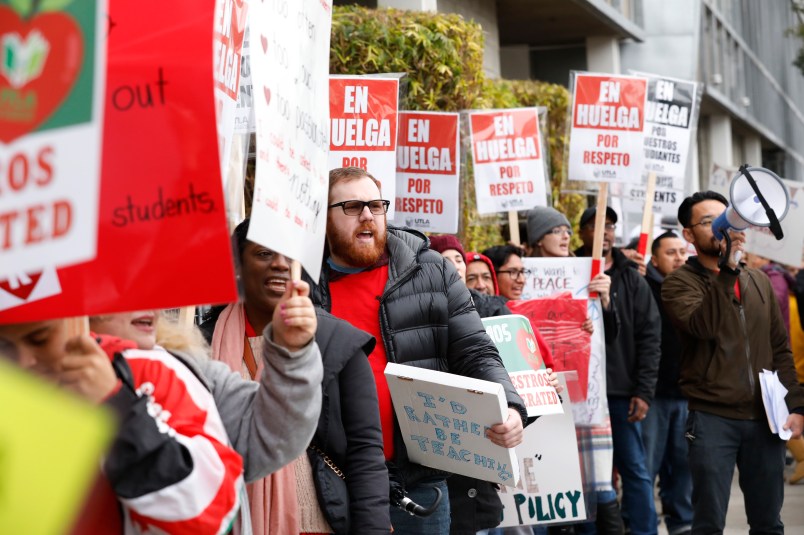LOS ANGELES (AP) — The head of the Los Angeles teachers union hinted at contract talks resuming Wednesday as striking educators in the nation’s second-largest school district protested outside hundreds of schools for a third day.
United Teachers Los Angeles President Alex Caputo-Pearl said the union had “engaged” Mayor Eric Garcetti to help in the dispute over pay, class sizes and support staff levels that led to the first strike in 30 years and prompted the school district to staff classrooms with substitute teachers.
Caputo-Pearl provided no further details. The mayor lacks authority over Los Angeles Unified School District but has been involved in seeking a resolution.
“We’ll have more information for you later in the day about the bargaining table and when we’re getting back to that bargaining table,” Caputo-Pearl told teachers rallying in the rain outside a high school.
Parents and children — one holding a sign saying, “This wouldn’t happen at Hogwarts” — joined the picket lines. Rocker and actor Steven Van Zandt, an advocate for arts education, also marched, saying teachers are on the front lines “fighting the war against ignorance.”
District officials are urging the union to resume negotiating but have said its demands could bankrupt the school system with 640,000 students.
“We need our educators back in our classrooms helping inspire our students,” Superintendent Austin Beutner said Tuesday.
All 1,240 K-12 schools in the district are open — a departure from successful strikes in other states that emboldened the LA union to act. Administrators have hired hundreds of substitutes to replace tens of thousands of teachers, which the union calls irresponsible.
The first day of the walkout Monday saw attendance plunge to about 144,000 students. That number grew to 159,000 on Tuesday. Students who miss classes during the strike will be marked absent, but each school’s principal will decide whether they face consequences, the district said.
Some parents who sent their kids to school wondered how much teaching was happening as students were gathered into large groups.
David Biener said his son and daughter completed worksheets in math and history while sitting on the gym floor at their middle school.
“It’s not an ideal situation, obviously, but there was some learning going on,” he said Tuesday. “It wasn’t a free-for-all.”
The union rejected the district’s latest offer to hire nearly 1,200 teachers, counselors, nurses and librarians and reduce class sizes by two students. It also included a previously proposed 6-percent raise over the first two years of a three-year contract. The union wants a 6.5 percent hike at the start of a two-year contract.
Caputo-Pearl, the union president, said members are “prepared to go as long as it takes” to get a fair contract. The last strike in 1989 lasted nine days.
Beutner, the superintendent, urged the teachers to join him in pushing for more funding from the state, which provides 90 percent of the district’s money.
Los Angeles Unified says teachers’ demands run up against an expected half-billion-dollar deficit this budget year and billions obligated for pension payments and health coverage for retired teachers.
“The painful truth is we just don’t have enough money,” Beutner said.
The union argues that the district is hoarding reserves of $1.8 billion. It represents more than 30,000 teachers who earn between $44,000 and $86,000 a year depending on education and experience.







I know three people who are retiring or have retired from LA Unified School District. Two are teachers and one an administrator. All are happy to get out and all note a change in the ability of students to focus (stay on task in teacher-talk). Some of the blame has to go to the hyperdistraction of “smart” phones. Another common observation was that wealth disparities have increased. The rich don’t attend public schools and poor parents have little participation in school life e.g. PTA. And there is the programming of instruction. In place of Nordic and Netherlands’ emphasis on novel problem-solving, CA K-12 has been increasingly in a programmed curriculum mode since the 1960s. US PISA scores are on par or below the scores of their Russian counterparts.